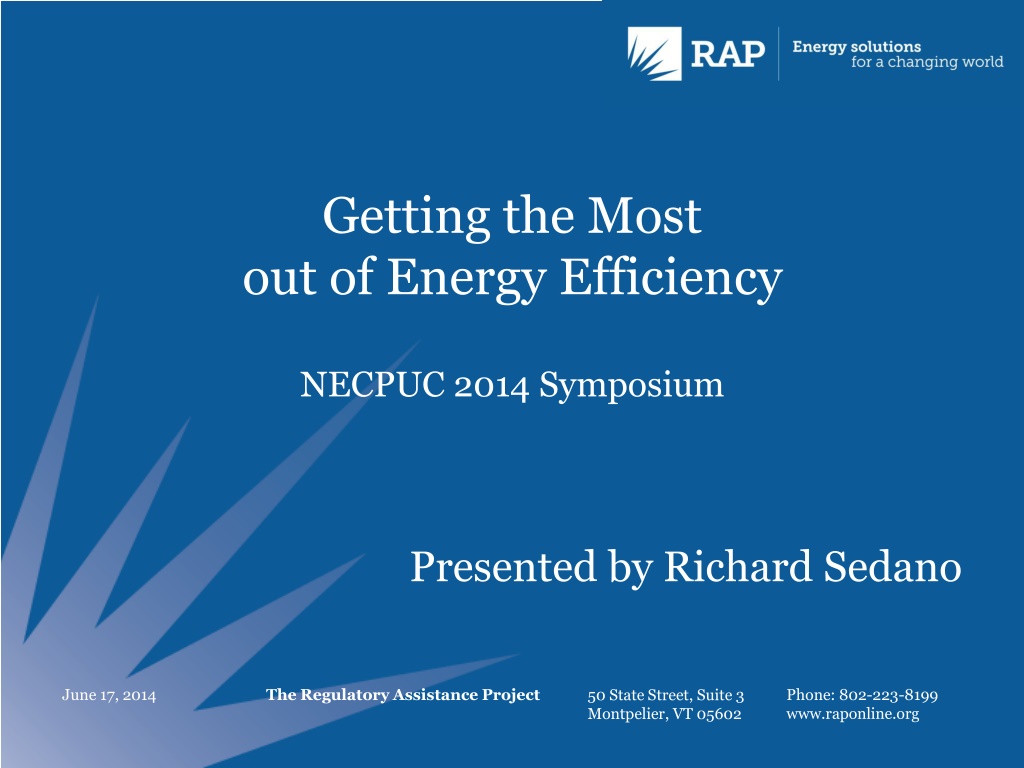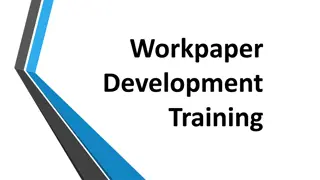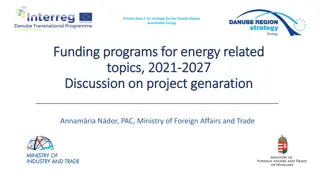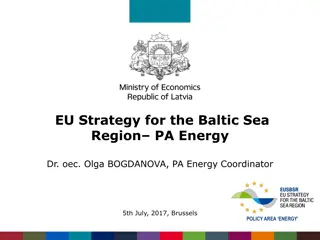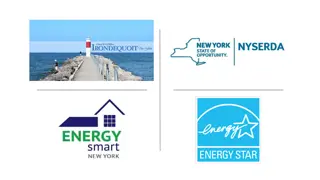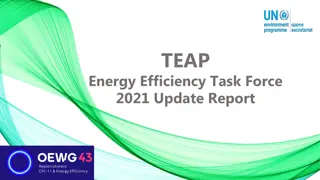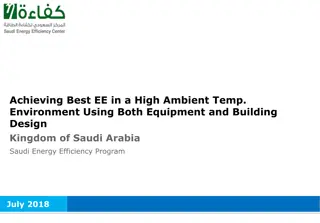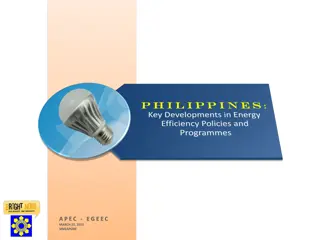Enhancing Energy Efficiency for Sustainable Development
This content covers a symposium on maximizing energy efficiency, presented by Richard Sedano at the NECPUC 2014 event. It introduces the Regulatory Assistance Project (RAP), a non-profit organization aiding government officials in energy and environmental issues with a focus on cost-effective energy efficiency strategies. The importance of securing all cost-effective energy efficiency, keys to enhancing cost-effectiveness, and valuing energy efficiency are discussed. The symposium emphasizes the need for more financial support, incentives for program administrators, and efficient delivery methods. It also highlights the significance of fully valuing energy efficiency in utilities and society. The content touches on benefit-cost analysis symmetry and ways to generate more funding from participants through various means like codes, standards, market transformation, and behavioral science.
- Energy Efficiency
- Sustainable Development
- Cost-effective Strategies
- Regulatory Assistance
- Financial Support
Download Presentation

Please find below an Image/Link to download the presentation.
The content on the website is provided AS IS for your information and personal use only. It may not be sold, licensed, or shared on other websites without obtaining consent from the author. Download presentation by click this link. If you encounter any issues during the download, it is possible that the publisher has removed the file from their server.
E N D
Presentation Transcript
Getting the Most out of Energy Efficiency NECPUC 2014 Symposium Presented by Richard Sedano June 17, 2014 The Regulatory Assistance Project Phone: 802-223-8199 www.raponline.org 50 State Street, Suite 3 Montpelier, VT 05602
Introducing RAP and Rich RAP is a non-profit organization providing technical and educational assistance to government officials on energy and environmental issues. RAP staff have extensive utility regulatory experience. RAP technical assistance to states is supported by US DOE, US EPA and foundations. Richard Sedano directs RAP s US Program. He was commissioner of the Vermont Department of Public Service from 1991-2001 and a former member of NECPUC. 2
Proposition No state is securing all cost-effective energy efficiency
Proposition No state is securing all cost-effective energy efficiency
Three Keys to More Cost-effective EE 1. More Money 2. Better Program Administrator Incentives 3. Better Delivery
1. More Money for Energy Efficiency Fully value energy efficiency Where does the money come from? (it all comes from us)
Fully Valuing Energy Efficiency Utility System value Participant value Societal value
Symmetry in Benefit Cost Analysis Include just system costs and benefits Include all costs and benefits including participants, noting that participants invest in energy efficiency for many reasons
More Money from Participants Codes and standards Market transformation Behavioral science Finance Great to help with $$$ and you need robust programs and information to articulate what the customer will finance or do beyond BAU
Maximum Use of Markets Reduce program costs Efficient use of resources System-wide programs maintain broad awareness
More money from utility consumers Yes Cost effective Means avoiding more expensive stuff Means reducing risks that might add more cost Divested generation attenuates analysis Wholesale market effects from energy efficiency matter and should count even if this is difficult
2. Program Administrator Incentives Remove counter incentives It s just good government Utilities affected with the public interest
Program Administrator Incentives Add positive incentives Earnings opportunities for success Recognize difference between compliance and excellence/innovation/inspiration Alignment Maximize the power of the utility to deliver public interest outcomes
Enterprise wide scope Outcome-based regulation Different skills from regulator and regulated Forces periodic conversation about priorities That is a good conversation
NY initiative: Reforming the Energy Vision PSC staff expressed interest in outcome- based regulation Expectation of more energy efficiency justified for that purpose Improved load factor (peak reduction) Improving system operating efficiency Reduced losses Avoided capital Geo-Targeted benefits plus use of Big Data Customers #1
Performance Focus on Energy Efficiency More complete connection between EE practices to public interest benefits Multi-year scope Use of milestones to manage flow and risk Market transformation Counting
Counting Measurement and Verification tends to be conservative Looking over our shoulder at those suspicious of energy efficiency Many important sources of energy efficiency can be counted to motivate PA Codes, standards, behavior, thermal improvements, especially across fuels, strategic reduction in fossil fuel dependence
Motivating Scoring Options Traditional EE programs credit Gross and Net Market Transformation credit Efficient Electrification credit Efficient Thermal Conversion credit
3. Better Delivery Make it easier for people/decision-makers to engage with energy efficiency Delivery channels where people already are Communities Faith based organizations Employers Comprehensive service providers (where permitted by utility regulation) Consumer get any energy service they want from whomever they want
Promoting Better Delivery Utility motivation on energy efficiency guides utility behavior on energy efficiency Motivation to secure all savings attributable to utility action Program administrator is in the scoring business Motivation to maximize overall savings regardless of attribution Program administrator is in the enabling business (NET) (GROSS)
Prioritizing Regulation is always about prioritizing Maximum cost-effective energy efficiency Mitigate climate change Save money from reduced system investment Reduce risk Motivate PA to do all it can do, including mobilizing others, and reduce EE soft costs Getting to 3%, 30% and beyond
About RAP The Regulatory Assistance Project (RAP) is a global, non-profit team of experts that focuses on the long-term economic and environmental sustainability of the power and natural gas sectors. RAP has deep expertise in regulatory and market policies that: Promote economic efficiency Protect the environment Ensure system reliability Allocate system benefits fairly among all consumers Learn more about RAP at www.raponline.org rsedano@raponline.org
